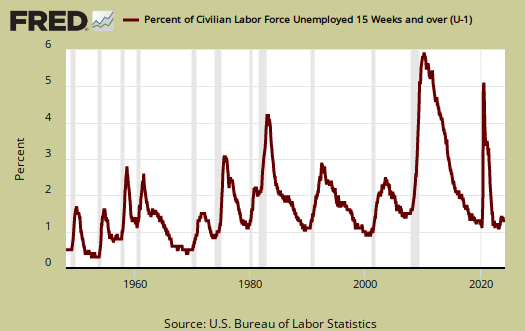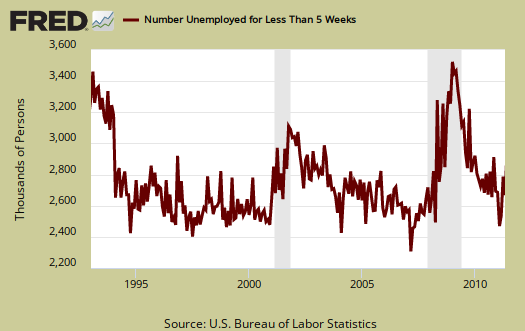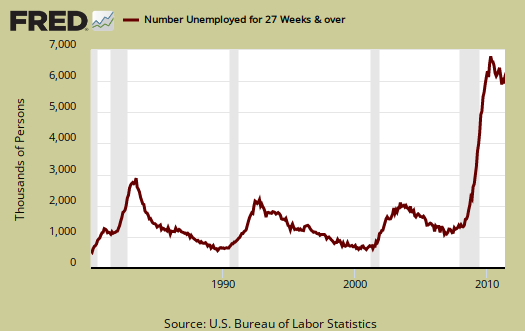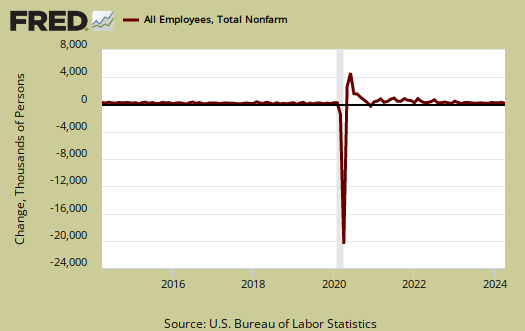This month's unemployment report is dismal, so maybe, just maybe we should demand policy makers start offering real solutions to the jobs crisis.
Earlier we reviewed the May 2011 BLS unemployment report. As if only 58,000 jobs was not bad enough, both April and March new jobs numbers were revised downward.
The change in total nonfarm payroll employment for March was revised from +221,000 to +194,000, and the change for April was revised from +244,000 to +232,000.
Let's drill down deeper to show just how badly America needs good jobs.
There are 13,914,000 people officially unemployed, and if one takes the alternative measure of unemployment, it's 24.4 million.
Below is a new graph, courtesy of the Saint Louis Federal Reserve, for the unemployment rate of just those unemployed 15 weeks or longer. 59.6% of the people who are officially counted as unemployed have been so 15 weeks or longer. The number of people unemployed 15 weeks or longer as part of the civilian labor force is 5.3%. Compare this to the official 9.1% unemployment rate. This means that it takes most people who are unemployed almost 4 months or more to find a job...if they do.

There are 2,664,000 people who are unemployed for less than 5 weeks in May, a decline of -27,000. People out of work 5 to 14 weeks dropped -15,000 and 15 to 26 weeks unemployed declined 22,000. Below is the graph of those unemployed for less than 5 weeks.

The below graph is the median time for being unemployed over the last 20 years. Look at the pathetic dramatic increase, which jumped in May to 22 weeks from 20.7. That means there is overall lost income by being out of work longer and we haven't even discussed how the new jobs are paying way less and most of the jobs being created are low paying jobs. The average time is even worse, 39.7 weeks. That's almost 10 months as the average time to find a job. There is a vast deviation from the average and the median duration of unemployment. This means there are huge percentages of the unemployed who simply cannot get a break!

Most of the unemployed increase occurred with those unemployed 27 weeks or longer. These long term unemployed increased by 361,000 people in May.
The problem with this number is we do not know the percentage of those who plain fell off the count and didn't get a job. 45.1% of the official unemployed have been so for 27 weeks or longer. Those employers refusing to give a job to someone who needs a job, refusing to hire someone unemployed....should be sued for discrimination in my opinion.
- Long term unemployed - 6.2 million
- Forced Part Time - 8.55 million
- Marginally attached to the labor force - 2.22 million
Of the Marginally attached, 1.083 million are discouraged. Forced part-time decreased -52,000 this month, with those reporting the reason is slack business conditions increasing by 145,000. People who could only get part-time work decreased -7,000 in May. The 2.22 million marginally attached are not counted in the official unemployment rate, but you can be guaranteed they do need a job. The BLS reports 6,821,000 people who are not counted actually want a job. That's huge.

U6, defined as total unemployed, plus all persons marginally attached to the labor force, plus total employed part time for economic reasons, as a percent of the civilian labor force plus all persons marginally attached to the labor force, (table A.15), was 15.8%.
To even get back to pre-recession unemployment rate levels we need a good 424,000 jobs created each month. That's permanent jobs. Even if the U.S. created 400,000 permanent jobs each month, it would take over 17 months to recover the jobs lost since December 2007, the start of the great recession, or 6.94 million jobs. If one created 400,000 jobs per month, to get to the start of the great recession unemployment rate of 5%, or roughly 10.7 million jobs, it would take over 26 months, or over 2 years to recover. Below is the seasonally adjusted monthly change in the number of payroll jobs in the U.S. See a lot of over 400,000 monthly increases in the past decade?

In looking over table B1 we can get a little more detail on what kind of jobs were created (and lost) on the permanent jobs front.
- Financial: +3,000
- Information: -1,000
- Construction: +2,000
- Manufacturing: -5,000
- Durable: +8,000
- Mining & Logging: +6,000
- Health and Education: +34,000
- Leisure and Hospitality: -6,000
- Professional & Business Services: +44,000
- Temporary Help: -1,200
- Professional &technical services: +40,300
- Accounting & Bookkeeping: +17,800
- Trade, Transportation, Utilities: +3,000
- Retail Trade: -8,500
- Government: -29,000
- Local Government: -28,000
While for some reason public or government workers are under assault, local government employees are clearly hurting. There has been 645,000 local government jobs lost since May 2010.
Below is the graph of the monthly change in manufacturing payroll jobs, seasonally adjusted, against the ISM Manufacturing Employment Index, which dropped -4.5 percentage points for May.

Bear in mind illegal workers and foreign guest workers are counted as employed Americans, which can distort occupational sectors, particularly the Engineering, I.T., Science and Technology ones. Below are the unemployment rates per occupational sector from table A-14, not seasonally adjusted.
- Financial: 6.8%
- Information: 7.3%
- Construction: 16.3%
- Manufacturing: 9.6%
- Transportation, Utilities: 8.0%
- Mining & Gas, Oil: 3.8%
- Health and Education: 5.7%
- Leisure and Hospitality: 10.6%
- Professional & Business Services: 9.8%
- Retail, Wholesale Trade: 9.0%
- "Other" Services: 8.4%
- Government: 3.9%
- Agricultural: 8.7%
- Self-employed, unpaid family: 6.1%
Probably the most horrific not seasonally adjusted unemployment rate is the 9.8% for Professional and Business Services unemployment rate. This occupation category implies a college degree. This particular area is fraught with foreign guest worker Visas, which distorts the real occupational unemployment rate. If an American is displaced by a foreign guest worker, then is forced to take a job at Walmart, that person is no longer categorized as a Chemical Engineering PhD out of work, but instead as a retail trade worker.
The above numbers are not seasonally adjusted so part of the agricultural and construction rates are due to the seasons, that said, construction unemployment has been decimated anyway you look at it.
The BLS also notes most of the new jobs in leisure & hospitality are low paying:
Over the past 3 months, this industry added 151,000 jobs, with nearly two-thirds of the growth in food services and drinking places.
The average work week was 34.4 hours, yet manufacturing average hours are 40.6. Average earnings for the private sector (drum roll please), increased 6¢, $22.98/hr. Yet the worker bees, or non-supervisory jobs average pay increased 6¢ to $19.43/hr. Take a look at how many industry sections are below full time hours. Is a common practice among employers to keep workers part-time, in order to deny them full-time benefits. These numbers have improved to more full time per industry.

You probably also want to know the birth/death model. What is that? It's a statistical adjustment to compensate for new businesses and dead businesses who are not actually tallied by data reports. Those jobs created and died outside the statistical reporting time window due to lag. So, the BLS estimates how many jobs can be attributed to those firms which are not actually counted. This month's adjustment was 206,000 jobs. One cannot directly subtract the birth/deal model monthly numbers, because unemployment data is seasonally adjusted, yet the birth/death adjustment is not seasonally adjusted, get that? Anywho, jobs attributed to new and dead businesses are just an estimate in so many words. Not seasonally adjusted, payrolls added 682,000 jobs. This is the reason why one cannot apply the birth/death model to seasonally adjusted data. Ok? You cannot mix them. If you want to take off the birth/death model you must do it to not seasonally adjusted data and then run the statistical algorithm to obtain the seasonally adjusted result.

Bad News as Motivator?
That's wishful thinking.
What on Earth the people in charge think the unemployed are supposed to do is anybody's guess.
I suppose they will continue their best not to think about us.
Good point. I worry that they have thought it through
Mark Provost said it well in Why the Rich Love High Unemployment and Numerian nailed it in a response to Robert's post on Jobs being the #1 issue, Corporations are not really interested in your plan. They benefit from this in some perverse way and they're in no hurry to fix it. What a massive betrayal of the citizens.
Michael Collins